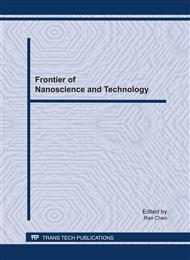[1]
A. Stolz Appl, Basic and Applied Aspects in the Microbial Degradation of Azo Dyes, Microbiol Biotechnol. 56 (2001) 69–80.
Google Scholar
[2]
P. W. Wong, T. T. Teng, N. A. R. N. Norulaini, Efficiency of the Coagulation-Flocculation Method for the Treatment of Dye Mixtures Containing Disperse and Reactive Dye, Water Quality Research Journal of Canada, (42) 2007 54-62.
DOI: 10.2166/wqrj.2007.008
Google Scholar
[3]
V.K. Guptaa, Suhas, Application of Low-Cost Adsorbents for Dye Removal – A review, Journal of Environmental Management. 90 (2009) 2313-2342.
DOI: 10.1016/j.jenvman.2008.11.017
Google Scholar
[4]
Ö. Yavuz, A. H. Aydin, Removal of Direct Dyes from Aqueous Solution Using Various Adsorbents, Polish Journal of Environmental Studies. 15 (2006) 155-161.
Google Scholar
[5]
A. R. Khataee, M. N. Pons, O. J. Zahraa, Photocatalytic Degradation of Three Azo Dyes Using Immobilized TiO2 Nanoparticles on Glass Plates Activated by UV Light Irradiation: Influence of Dye Molecular Structure, Hazard Mater. 168 (2009) 451-457.
DOI: 10.1016/j.jhazmat.2009.02.052
Google Scholar
[6]
S.K. Kansal, M. Singh, D. Sud, Studies on Photodegradation of Two Commercial Dyes in Aqueous Phase Using Different Photocatalysts, Journal of Hazardous Materials. 141 ( 2007) 581-590.
DOI: 10.1016/j.jhazmat.2006.07.035
Google Scholar
[7]
R.Y. Hong, J.H. Li, L.L. Chen, D.Q. Liu, H.Z. Li, Y. Zheng, J. Ding, Synthesis, surface modification and photocatalytic property of ZnO nanoparticles, Powder Technology. 189 (2009) 426–432.
DOI: 10.1016/j.powtec.2008.07.004
Google Scholar
[8]
R. Ullah, J. Dutta, Photocatalytic Degradation of Organic Dyes with Manganese-Doped Zno Nanoparticles, Journal of Hazardous Materials. 156 (2008) 194–200.
DOI: 10.1016/j.jhazmat.2007.12.033
Google Scholar
[9]
M.A. BEHNAJADY, N. MODIRSHAHLA, M. SHOKRI, B. RAD, Enhancement of Photocatalytic Activity of TiO2 Nanoparticles by Silver Doping: Photodeposition Versus Liquid Impregnation Methods, Global NEST Journal. 10 (2008) 1-7.
DOI: 10.30955/gnj.000485
Google Scholar
[10]
S. Baruah, S. S. Sinha, B. Ghosh, S. K. Pal, A. K. Raychaudhuri, J. Dutta, Photoreactivity of ZnO Nanoparticles in Visible Light: Effect of Surface States on Electron Transfer Reaction, Journal of Applied Physics. 105 (2009).
DOI: 10.1063/1.3100221
Google Scholar


